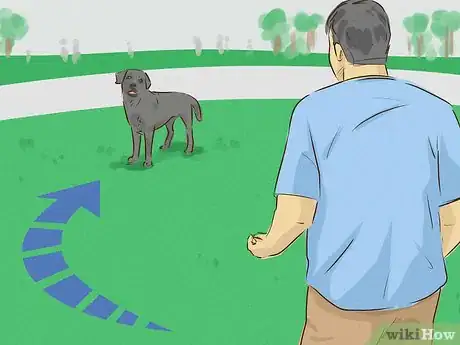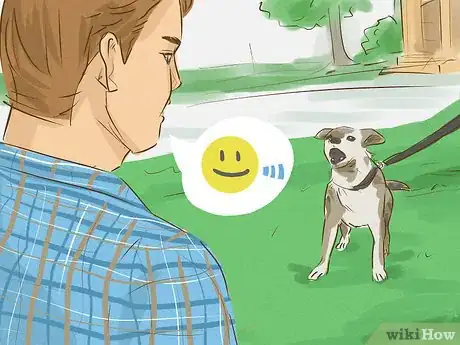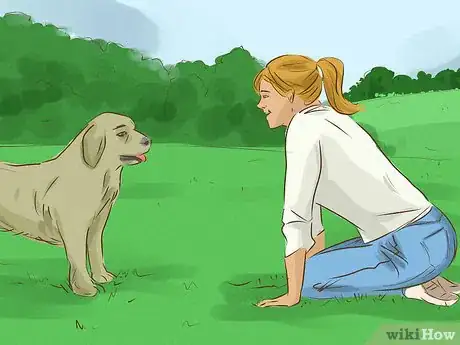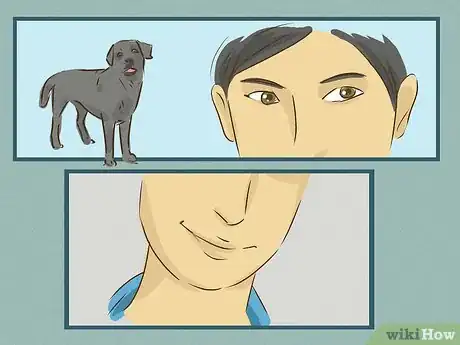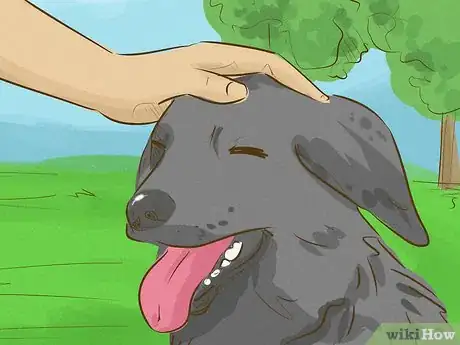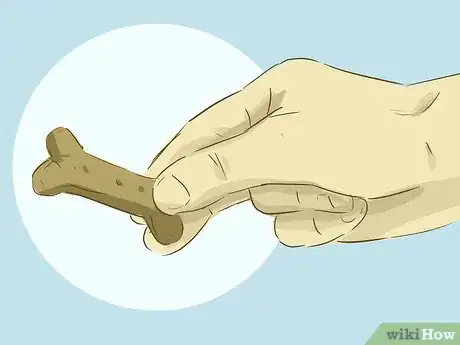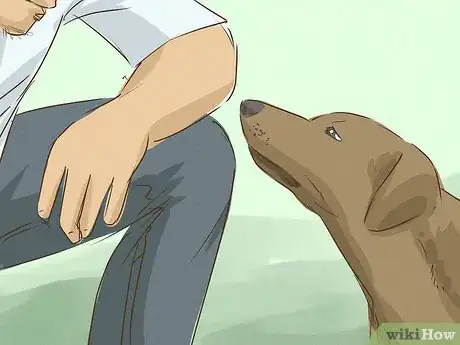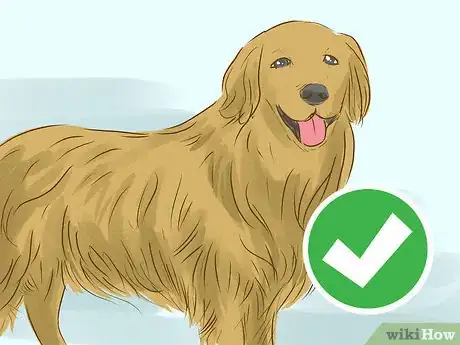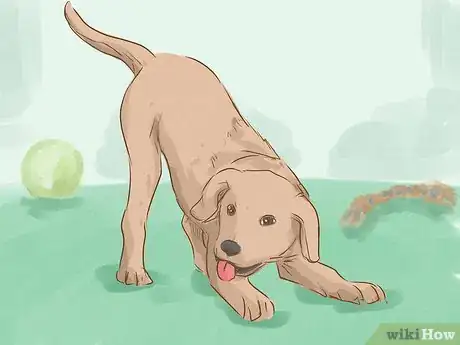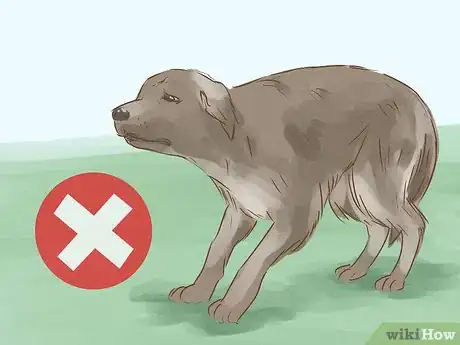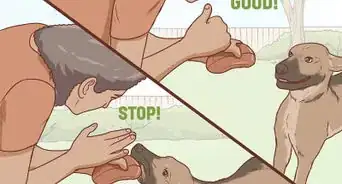This article was co-authored by Elisabeth Weiss and by wikiHow staff writer, Jessica Gibson. Elisabeth Weiss is a Professional Dog Trainer and owner of Dog Relations NYC, a dog training service in New York, New York. Elisabeth relies on science-based, force-free, and reward-based techniques. Elisabeth offers behavior training, puppy manners, body awareness and injury prevention, diet, exercise and dog nutrition services. Her work has been featured in New York Magazine and on the Dog Save the People podcast. She also trained all the dogs in the movie "Heart of a Dog" by Laurie Anderson that features Elisabeth's journey with Laurie Anderson's and Lou Reed's dog Lolabelle and how her passion for playing the keyboards played a significant role in improving her quality of life after being diagnosed with pancreatic cancer.
There are 8 references cited in this article, which can be found at the bottom of the page.
This article has been viewed 43,212 times.
Do dogs run away from you despite your friendly demeanor? If you'd like to make dogs more comfortable around you, start by changing the way you move and speak around them. Dogs will be more relaxed if you move slowly, speak gently, and get down on their level. Give a dog plenty of time to look you over before trying to pet it and recognize signs that the dog needs more time or space.
Steps
Adjusting Your Body Language
-
1Move slowly around the dog. If you're quick or unpredictable in how you walk or move, the dog might be frightened by you. Make the effort to be slow and predictable in how you move when you're around the dog.
- Moving slowly will give the dog a chance to inspect you and watch your body language.
Tip: Instead of approaching the dog head on, walk towards the dog in a curved line. This will prevent the dog from feeling threatened.
-
2Speak to the dog in a calm voice. This is especially important if the dog is barking or appears frantic. Talking to the dog in a soothing voice can make it feel relaxed and more comfortable around you.[1]
- For example, say, "Hi Sammie. You seem excited about something. How are you doing?"
Advertisement -
3Squat or sit down so you're closer to the dog's level. Some dogs are intimidated by people towering over them, so get down when you're close to the dog. You might find that the dog is curious about you once you get down on its level.[2]
- Don't be surprised if the dog is more interested in sniffing your shoes than checking you out. Your shoes carry a lot of scents that the dog might try to figure out.
-
4Smile at the dog and make minimal eye contact. You can make direct eye contact, but avoid staring for very long or the dog may feel threatened or challenged.[3] Glance at the dog and smile. This can make the dog feel relaxed.
- Research shows that dogs can detect anger in facial expressions, so smiling is an important way to appear friendly.
-
5Pet the dog gently if it comes close to you. Give the dog time to get comfortable, and gradually extend your hand if it comes up to you.[4] Slowly pet the dog and see how it reacts. If the dog stays near you or moves even closer, it enjoys the attention.[5]
- If the dog pulls away, don't continue to pet it. Give the dog a little space and see if it comes back. The dog might just want a little more time to observe you.
- Don't immediately touch the dog's head, as they might take that as a threatening gesture.[6]
-
6Play with the dog or offer it a toy. If the dog seems comfortable around you, spend some time playing with it. Dogs love to play tug-of-war with a rope, fetch a ball or stick, and play tag with you. You can also give the dog a toy, such as:[7]
- Tennis balls
- Soft toys
- Squeaker toys
-
7Offer the dog a treat. If you're interacting with someone else's dog, ask them if it's all right for you to give it a treat. Hold a dog treat in your open palm and slowly hold it out to the dog. Let the dog come over to you to get the treat.[8]
- Don't expect the dog to do tricks to earn the treat if you aren't familiar with the dog.
- An anxious dog may not want to approach you, even to get treats. Instead of waiting for the dog to come to you, toss the treats so they land near the dog. This will help build the dog’s trust and confidence.
Paying Attention to a Dog's Body Language
-
1Let the dog smell you if it looks alert and curious. Instead of rushing over to the dog and trying to hug it, determine if the dog is interested in you. It might stand up straight and even lean forward a little while keeping its tail parallel to the ground. The dog may come over to sniff your open hand.[9]
- You'll notice the dog's eyes are wide and its ears are directed forward as if the dog is trying to take in the sight and sound of you.
-
2Approach the dog if it looks relaxed. You can initiate contact if the dog's body looks comfortable. Its tail may be low to the ground and its ears are pointing up instead of forward. A calm dog might also have its mouth open so its tongue hangs out a little.[10]
- Remember that even though a dog appears relaxed, you should still approach it slowly and calmly.
-
3Recognize when the dog wants to play. If a dog thinks you're friendly and wants to play with you, it may bark and lower its front paws. Its tail and ears will perk up before the dog starts moving around you energetically.[11]
- You might notice the dog's pupils dilate and it will keep its mouth open.
-
4Give the dog space if it looks frightened or worried. The dog may not want to interact if it turns its head away from you, lowers its ears, and keeps its head down. If it's afraid, its paws might look sweaty and it will keep its body low.[12]
- If the dog is showing these signs, don't get close to it or attempt to engage it.
- Even if the dog just seems a little unsure about you, leave them alone until they're more comfortable.[13]
Expert Q&A
Did you know you can get expert answers for this article?
Unlock expert answers by supporting wikiHow
-
QuestionHow can I make a dog comfortable around me?
 Elisabeth WeissElisabeth Weiss is a Professional Dog Trainer and owner of Dog Relations NYC, a dog training service in New York, New York. Elisabeth relies on science-based, force-free, and reward-based techniques. Elisabeth offers behavior training, puppy manners, body awareness and injury prevention, diet, exercise and dog nutrition services. Her work has been featured in New York Magazine and on the Dog Save the People podcast. She also trained all the dogs in the movie "Heart of a Dog" by Laurie Anderson that features Elisabeth's journey with Laurie Anderson's and Lou Reed's dog Lolabelle and how her passion for playing the keyboards played a significant role in improving her quality of life after being diagnosed with pancreatic cancer.
Elisabeth WeissElisabeth Weiss is a Professional Dog Trainer and owner of Dog Relations NYC, a dog training service in New York, New York. Elisabeth relies on science-based, force-free, and reward-based techniques. Elisabeth offers behavior training, puppy manners, body awareness and injury prevention, diet, exercise and dog nutrition services. Her work has been featured in New York Magazine and on the Dog Save the People podcast. She also trained all the dogs in the movie "Heart of a Dog" by Laurie Anderson that features Elisabeth's journey with Laurie Anderson's and Lou Reed's dog Lolabelle and how her passion for playing the keyboards played a significant role in improving her quality of life after being diagnosed with pancreatic cancer.
Professional Dog Trainer
-
QuestionI saw this dog running out on the road. I told the owner and they have done nothing about it so the dog keeps escaping. I will call the RSPCA but I need to get friendly with the dog to do this. Any advice?
 Community AnswerThe first thing you don't want to do is call the dog over. If you call it or run to it, the thing they are most likely going to do is run away. Now, most dogs aren't like this, some are nice and go to the nearest person they see, but that happens 30% of the time. If you see the dog walk by, don't look or try to touch the dog. They will most likely bark, but once they know who you are they will start to warm up to you.
Community AnswerThe first thing you don't want to do is call the dog over. If you call it or run to it, the thing they are most likely going to do is run away. Now, most dogs aren't like this, some are nice and go to the nearest person they see, but that happens 30% of the time. If you see the dog walk by, don't look or try to touch the dog. They will most likely bark, but once they know who you are they will start to warm up to you. -
QuestionHow do I approach a fearful dog to take it outside to go potty? We can pet him but he takes off if we try to pick him up.
 Violet MichellCommunity AnswerTry and put a harness or lead on the dog. If the dog is not yours, do not try and do anything with it. If it is yours, give it food, and give it plenty of pats. Eventually it will be able to be picked up. Let it into the garden/yard to potty; you should do not have to pick it up or force it to go outside.
Violet MichellCommunity AnswerTry and put a harness or lead on the dog. If the dog is not yours, do not try and do anything with it. If it is yours, give it food, and give it plenty of pats. Eventually it will be able to be picked up. Let it into the garden/yard to potty; you should do not have to pick it up or force it to go outside.
References
- ↑ http://chasingdogtales.com/how-our-tone-of-voice-affects-dogs/
- ↑ https://www.somethingwagging.com/get-down-on-your-dogs-level-quick-tips/
- ↑ Elisabeth Weiss. Professional Dog Trainer. Expert Interview. 3 September 2020.
- ↑ Elisabeth Weiss. Professional Dog Trainer. Expert Interview. 3 September 2020.
- ↑ https://www.companionanimalpsychology.com/2018/05/how-to-pet-cats-and-dogs.html
- ↑ Elisabeth Weiss. Professional Dog Trainer. Expert Interview. 3 September 2020.
- ↑ https://www.mnn.com/family/pets/stories/7-rainy-day-games-to-play-with-your-dog
- ↑ https://thebark.com/content/please-dont-treat-my-dog
- ↑ https://moderndogmagazine.com/articles/how-read-your-dogs-body-language/415
- ↑ https://www.sciencealert.com/seven-weird-dog-behaviors-and-what-they-mean
- ↑ https://moderndogmagazine.com/articles/how-read-your-dogs-body-language/415
- ↑ https://www.sciencealert.com/seven-weird-dog-behaviors-and-what-they-mean
- ↑ Elisabeth Weiss. Professional Dog Trainer. Expert Interview. 3 September 2020.
About This Article
Dogs actually read a lot into our body language, and there are things you can do to make yourself appear friendlier and less threatening to new dogs you meet. Try to move slowly around new dogs, and avoid making direct eye contact for a prolonged period of time so they don't feel threatened. Get down on their level if you can so you're not towering over them. Wait for them to approach you on their own terms. If they do, extend your hand and let them sniff it. Try petting them if they seem comfortable, but don't push it if they pull away. If you have a treat or toy on hand, definitely offer it to the dog to help win them over. For more advice, like how to tell how a dog is feeling based on their body language, check out the full article below!
